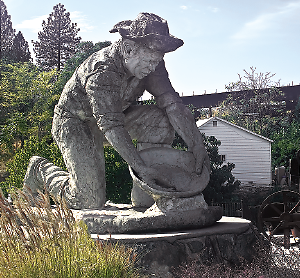Search for Treasure Is Woven Into Tapestry of City’s History
Abstract
Seismic events other than earthquakes have shaped San Francisco’s modern history. One might say that these events have been propelled by people’s hunger for treasure—either of a financial nature or a psychological or spiritual one.
Defining modern San Francisco is a challenge by anyone’s standards. Perhaps the best description is that of a city of hills, fog, earthquakes, and the search for treasure—either of a financial nature or a psychological-spiritual one.

This is the famous Auburn Miner statue—a longtime city landmark in Auburn, Calif., an old Gold Rush city near San Francisco.
Let’s start with the Gold Rush. In 1848, gold nuggets were discovered in the foothills northeast of San Francisco where a Swiss immigrant, John Sutter, was building a saw mill. The discovery prompted thousands of speculators to inundate San Francisco. Most gold seekers, however, found only enough gold to pay for their daily expenses—if they were among the fortunate few, that is. Even Sutter, who had wanted to create a utopian agricultural settlement, was quoted in 1857 as saying, “What a great misfortune was this sudden gold discovery for me! From my mill buildings I reaped no benefit whatever, the mill stones even have been stolen and sold.”
By the start of the 20th century, San Francisco had struck it rich again. Its U.S. mint contained a third of the country’s gold supplies. It was the largest city on the West Coast, the financial center of the Western United States, and famous for its ostentatious mansions, stately hotels, and the flamboyant lifestyle of its citizens. Then misfortune struck in 1906 when a powerful earthquake devastated the city. As buildings collapsed, ruptured gas lines ignited fires that rapidly spread throughout the city. Several thousand people died. More than half the city’s population were left homeless.
But San Francisco rose once again, reinventing itself to become a financial powerhouse. In the wake of the 1929 stock market crash, not a single San Francisco bank failed. Construction of the Golden Gate Bridge was started in 1933 and was funded by city bonds purchased by Amadeo Giannini, the founder of the San Francisco-based Bank of America. Giannini purchased the bonds to help the local economy. The bridge opened in 1937.
In the summer of 1967, San Francisco acquired a new image and wealth of a less tangible nature than gold or currency. Thousands of young people—so-called hippies or flower children—flocked into the city’s Haight-Ashbury neighborhood. The migration was called the Summer of Love. “It was sex, drugs, and rock and roll, and those were all fun,” author and social satirist Paul Krassner commented in a 2007 San Francisco Chronicle article. “But at the core of this counterculture was a spiritual revolution, in a sense of leaving the Western religions of control and exploring the Eastern disciplines of liberation.” And as civil-rights lawyer Angela Alioto was quoted as saying in the same issue of the Chronicle, “The Summer of Love really stressed the principles of St. Francis of Assisi, the guy who loved the environment, loved animals, loved the sick and poor, and was against war…The Summer of Love was flat-out beautiful!”
More searching for liberation and psychological-spiritual treasure was to follow during the 1970s as San Franciscans exercised a prominent role in the vanguard of the national gay-rights movement. During that time, San Francisco Supervisor Harvey Milk became California’s first openly gay elected official and one of the first anywhere in the country. Today San Francisco remains a mecca for gays and lesbians from all across the globe.
But the search in San Francisco for financial treasure was not over. Real-estate moguls built an array of skyscrapers during the 1980s. The dot-com boom exploded in San Francisco during the late 1990s as newly minted millionaires and billionaires became legion. Although the boom ended in 2001 when tech stocks crashed, new Internet and software companies were launched in the city beginning in 2003. Last year, still more high-tech companies such as Twitter moved there.
In 2011, San Francisco elected Edwin Lee as mayor. He is the first Chinese-American mayor in San Francisco’s history as well as the first Asian American elected to the office. His election is yet another example of San Franciscans’ embrace of diversity and openness to people from a wide variety of backgrounds. ■
More information about San Francisco’s history is posted at http://www.zpub.com/sf/history/sfh2.html.



